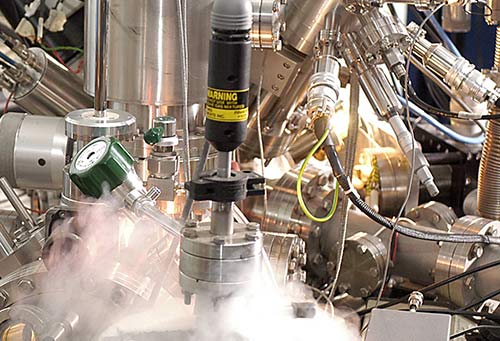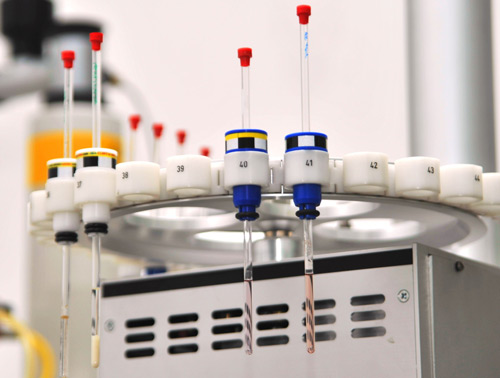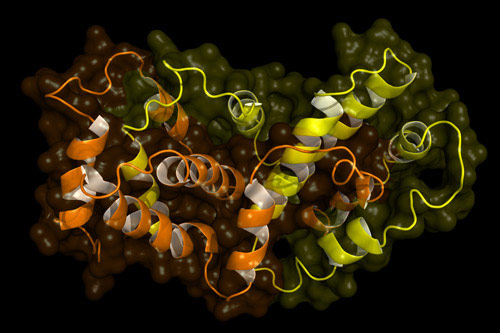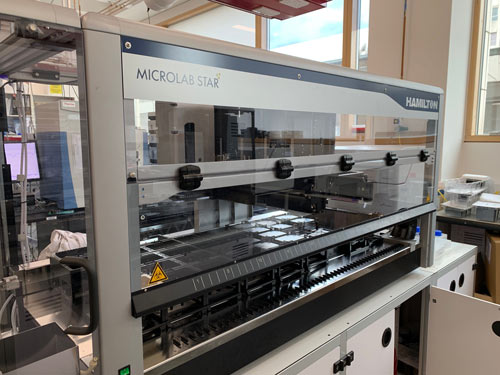Facilities
MIB houses a range of outstanding research facilities that benefit our research teams and industry partners. Our facilities are supported by a team of dedicated experimental officers who provide a flexible service of support and collaboration.
Facilities technical specification
A full inventory of our equipment can be accessed here:
Our facilities are open to not only our own research community, but also researchers from other educational institutions and industry scientists. Our labs and facilities are specifically designed to accommodate a range of research needs, including anaerobic facilities so experiments can be carried out in an oxygen-free environment.
You can find out more about our facilities by selecting from the list below, or you can get in touch if you require further information our would like to request time on our equipment.
Chromatography and analytical
We have a range of analytical instruments available to separate and analyse biological and chemical compounds for qualitative and quantitative purposes.
Applications
- Separation and quantitative analysis of volatile compounds
- Product identification by NIST MS search
- Fully automated headspace analysis and liquid injection
- Additional Agilent GC (FID) with standard liquid autosampler available upon request
Equipment
- Range of HPLC instruments with different capabilities, both analytical and preparative
- DAD, Refractive Index and Evaporating Light Scattering detection
- HTP UHPLC systems
- Super Critical Fluid Chromatography
- Chiral HPLC screening service
- Walk-up FTIR and Polarimeter for analysis of small molecules
Enquiries
Computational chemistry

We use a range of computational methodologies to simulate protein function and dynamics.
Applications
- Understanding the atomic origin of experimental measurements
- Studying catalytically important dynamics and protein conformational changes
- Explaining / predicting effect of mutations
- Analysing enzymatic mechanisms and kinetics
Techniques
- Molecular dynamics (MD) simulations
- Enhanced sampling MD (e.g. umbrella sampling, metadynamics)
- Quantum mechanical calculations (e.g. DFT)
- Docking of ligands / substrates / inhibitors
Enquiries
EPR
Electron Paramagnetic Resonance (EPR) spectroscopy is a powerful technique for studying molecules with unpaired electrons (i.e. radicals and open-shell metal ions). The technique is analogous to NMR, but has superior sensitivity and no real size limit to the samples that can be studied, with many measurements made on frozen samples. EPR is particularly useful for the study of metalloproteins, such as cytochromes (P450 BM3) and iron-sulfur proteins (CntB reductase), copper containing enzymes (LPMO and CuNiRs), non-heme mono(CntA)/binuclear(ADO) enzymes and those enzymes with (quasi)stable radical intermediates such as flavoenzymes or photosynthetic complexes. The MIB EPR facility’s focus is the study of radical/metal-containing biomolecules such as cofactors, metalloproteins and radical enzymes. The facility houses a Bruker ELEXSYS E580 spectrometer operating at X-band (~ 9.5 GHz) that is capable of performing both continuous wave (CW) and pulsed EPR measurements at temperatures ranging from ~ 5K to RT.
Applications
- Continuous-wave (CW) EPR
- Electron nuclear double resonance techniques (ENDOR)
- Davies and Mims-ENDOR
- Electron spin echo envelope modulation (ESEEM)
- 2p-ESEEM, 3p-ESEEM and Hyperfine Sublevel Correlation (HYSCORE)
- Electron-electron double resonance (ELDOR/PELDOR/DEER) - typically on a spin-labelled nitroxide samples, M-nitroxide (M = Mn2+, Fe3+, Cu2+), Cu2+-Cu2+
- Relaxation Induced Dipolar Modulation Enhancement (RIDME) – typically on a hetero spin-pair like M-nitroxide (M = Mn2+, Fe3+, Cu2+)
- ELDOR detected NMR (EDNMR) – covers a frequency range of 0-300 MHz; simultaneous detection both single and double quantum transitions
- Rapid-freeze quench with subsequent EPR characterization (CW/pulsed)
- EPR interfaced to MiniLite Laser (355 and 532 nm) for time-resolved EPR (photo-induced catalytic reactions; enzymes and inorganic mimics)
- 60Co-gamma irradiation and Photoactivated NADH induced Reduction of metalloenzymes and annealing experiments
- Characterization of reactive oxygenic/nitrogenic species (ROS/RNS) using spin-trap/spin-probe
Enquiries
Mass spectrometry

We are well equipped in mass spectrometry and related hardware to study biological molecules, ranging from small metabolites to large protein complexes. We offer Experimental Officer led analysis to provide accurate mass, structure, abundance and identification and provide training and support in acquisition and data processing. We also support longer term research projects in the use and development of mass spectrometry.
Capabilities
- Hyphenated MS techniques (UPLC-MS, GC-MS, TD1-GC-MS, Volatile-PTR2 MS)
- Untargeted to Targeted metabolomics and Proteomics
- MALDI-MS, DESI3-IM-MS
- Native Ion-Mobility MS mass, structure and conformational change
- Innovative MS techniques (HDX4-MS, activated IM5-IMc, Photo-IM-MS, Paper sprayd)
Associated Centres
Enquiries
NMR

We use NMR to provide very detailed atomic resolution information on the structure and dynamics of small molecules and biological macromolecules.
Applications
- Structural biology in solution state
- Atomic resolution biophysics (eg order parameters for comparison with MD simulations) H-D exchange (small molecules to medium sized proteins).
- 2D structures of complex molecules (carbohydrates, natural products)
- Analysis of complex mixtures (reaction dynamics, metabolomics)
- Product identification - de novo or comparison to standards
- Isotope measurements
Equipment
- 800 MHz Bruker four-channel liquid-state spectrometer
Equipped with a high sensitivity TCI CryoProbe with cooled proton and carbon channel. - 500 MHz Bruker five-channel liquid-state spectrometer
Equipped with a high sensitivity QXI cryoprobe with cooled proton, fluorine and carbon channel. Fluorine NMR provides additional information to the standard nuclei set of 1H, 13C and 15N. - 400 MHz NMR spectrometer
Carbon and proton detection for small molecule work. This is a walk-up service spectrometer for determining the results of chemical syntheses.
Enquires
Protein structure

We use state-of-the-art equipment and X-ray diffraction by single protein crystals to elucidate 3D structures at atomic resolution.
We provide a complete service from solution to structure and offer the following services:
- Target selection
- Construct design
- Protein purification guidance
- Crystallogenesis screening
- Hit optimisation
- Data collection
- Structure determination
- Model building / refinement
Enquiries
Robotics, automation and high-throughput screening

We have a range of tools and technology platforms that support the engineering of biology through high throughput directed evolution and synthetic biology protocols.
Our automation suite includes pipette and acoustic liquid handling robots which have been programmed with standard operating and tailored protocols to allow diverse experimental functionality.
A new integrated robotics platform has a plate handling robotic delivery arm that integrates acoustic and pipette based liquid handling with an array of smaller instruments for fully automated (24/7) workflows. To complement this facility automated colony picking (QPix 420) and next generation sequencing (PacBio Sequel) are also available.
Applications
- Sterile media dispensing and barcoded sample management
- Automated DNA/RNA library generation
- Cloning and colony picking
- Pathway assembly protocols (e.g. LCR)
- PCR, DNA clean-up and manipulations
- Target product extraction and purification protocols
- Range of high throughput assays and analysis
Equipment
- Hamilton STAR robots (x 2) – with plate reader and incubation
- Tecan EVO 200 (RNA/DNA, SELEX)
- ECHO 650 (high precision, high speed, non-contact, low volume droplet transfer in 384 and 1536 well plates)
- Fully integrated robotics platform (2 Hamilton STARs, ECHO, plate sealers/de-sealers/washer and reader, centrifuges, PCR machines and Cytomat 2 (3) & 10 incubators)
- QPix automated colony picker
- Pac Bio Sequel next generation sequencer
- Pico-droplet fluidics system (Sphere Fluidics)
Next generation sequencing / microfluids enquiries
Robotics enquires
Spectroscopic and kinetic
We offer a range of spectroscopic and kinetic techniques to understand reaction mechanisms, measure ligand binding events and study catalytic and structural processes in biological molecules.
Applications
- Enzyme assays: from development through to high-throughput capabilities
- Understanding reaction mechanisms
- Identifying reaction intermediates, rates of individual steps in catalysis, and rate-limiting steps in a reaction
- Optimising reaction conditions
- Inhibitor studies
- Ligand binding assays
- Protein-protein interactions
- Anaerobic reactions
- Redox chemistry
Techniques
- Stopped-flow spectroscopy (visible/IR detection, high pressure, freeze-quench)
- Time-resolved laser spectroscopy (from femtosecond through to hours, visible and IR detection)
- Advanced fluorescence (lifetimes, anisotropy, etc.)
- UV/vis/nIR/ absorbance
- FTIR spectroscopy
- Circular dichroism
- Raman spectroscopy
- Electrochemical approaches
- Anaerobic facilities
